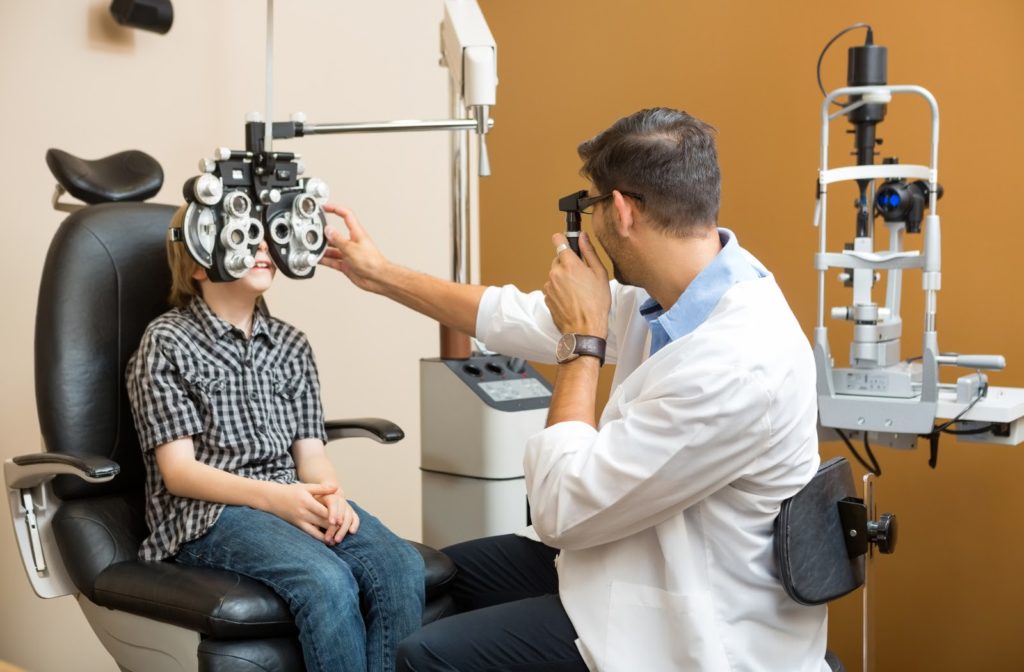Children can have their first comprehensive eye exam as early as 6 months of age. If you suspect your child is having problems with their eyesight, book an eye exam for them as soon as possible. If any problems with your child’s eyes go undiagnosed, it can greatly impact their ability to learn at school and will affect the quality of their eyesight later on in life.
What to Expect From Your Child’s First Eye Exam
A children’s eye exam will typically start with questions about their family and medical history. During the exam, your optometrist will test your child for any signs of eye diseases. Your optometrist will also test for any refractive errors and will pay close attention to your child’s visual acuity and binocular vision. Lastly, your optometrist will also assess your child’s general eye health. If any particular issues are present, your optometrist will strategize with you on how to manage the problem.
How Often Should Your Child Get an Eye Exam?
Children can have their first comprehensive eye exam as early as 6 months of age, then they should have their eyes examined at age 3 and just before they enter the first grade (age 5 or 6). School-aged children should have an eye exam at least every 2 years if no vision correction is required.
Your optometrist may recommend more frequent examinations if your child is struggling with more severe vision problems or eye health.
Vision Skills
These are skills that are important for the healthy development of your child’s eyes:
- Visual acuity – the ability to see clearly in the distance for viewing the chalkboard, at an intermediate distance for the computer, and up close for reading a book.
- Eye focusing – the ability to quickly and accurately maintain clear vision as the distance from objects change, such as when looking from the chalkboard to a paper on the desk and back.
- Eye-tracking – the ability to keep the eyes on target when looking from one object to another, moving the eyes along a printed page, or following a moving object like a thrown ball.
- Eye teaming – the ability to coordinate and use both eyes together when moving the eyes along a printed page, and to be able to judge distances and see depth for classwork and sports.
- Hand-eye coordination – the ability to use visual information to monitor and direct the hands when drawing a picture or trying to hit a ball.
- Visual perception – the ability to organize images on a printed page into letters, words, and ideas and to understand and remember what is read.
Signs That Your Child Needs Corrective Lenses
Proper development of healthy eyes at a young age greatly impacts your child’s ability to grow and learn. Knowing some of the signs that indicate that your child may need corrective lenses is important to consider before taking your child in for their first eye exam.

Squinting Eyes and Tilting Head
If you find your child is squinting or tilting their head when they are looking at things far away, it may be a sign that they have myopia (nearsightedness). If myopia is diagnosed early on in a child’s life, effective control measures can be taken to lessen its effects. Some of the measures include atropine eye drops, and specialty myopia control glasses or contact lenses.
Covering One Eye to See
This might indicate that your child sees better out of one eye compared to the other. Your child may have amblyopia or astigmatism in one eye. These conditions can range from severe to almost negligible; booking an eye exam for your child is the best way to see if they need glasses as a correctional measure for their eyesight. An easy way to tell which eye your child is having trouble with is by covering each of their eyes one at a time then asking them what they can see and which eye sees more clearly.
Extreme Light Sensitivity and Headaches
This issue can arise due to your child being photophobic (sensitive to light). Special eyeglass lenses and sunglasses can help reduce the severity of your child’s sensitivity to light and can help them see more clearly in bright conditions.
If your child is getting headaches when they are outside for some time, this can be a sign that they are photophobic.
Losing Their Place While Reading
Astigmatism or strabismus can be the root cause of your child losing their place while reading. If your child signifies to you that they cannot make sense of what is on a page or says that the text they try to read gets distorted or blurry, this can be an indication that they need glasses. Getting your child to read aloud to you can be a great way to build up their literacy skills, but also gives you a chance to monitor their eyesight and ability to read text.
Sitting Very Close to Screens
If your child needs to sit very close to screens to see them clearly or needs to get very close to written text to read it, it can be another sign that they have myopia. Being too close to digital screens can have detrimental effects on eyesight at an early age, and eyeglasses should be considered to alleviate the issues your child is having with myopia.
Performance in School
Your child may be having difficulties in school due to not being able to see the information on computers and whiteboards. Most often it is an issue dealing with nearsightedness, but other ailments such as color blindness may be the cause of their impaired vision. Ask your child if they think reading the information on a whiteboard is hard, and ask them where they sit relative to the board in their classroom. This will give you an indication of the eyesight issue that might be prevalent.



